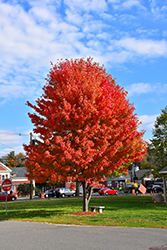It's all about ...
plants

Autumn Splendor Sugar Maple
Acer saccharum 'Autumn Splendor'
Height: 45 feet
Spread: 40 feet
Sunlight:
![]()
Hardiness Zone: 6a
Other Names: Caddo Maple, Hard Maple, Rock Maple
Description:
A majestic shade tree noted for its reliable burnt orange to red fall color; very resistant to heat, drought, and leaf tatter; adaptable to soils, but dislikes air pollution and compaction; vigorous, with a broadly oval to rounded shape
Ornamental Features
Autumn Splendor Sugar Maple has dark green deciduous foliage on a tree with an oval habit of growth. The glossy lobed leaves turn outstanding shades of orange and in the fall.
Landscape Attributes
Autumn Splendor Sugar Maple is a dense deciduous tree with a shapely oval form. Its average texture blends into the landscape, but can be balanced by one or two finer or coarser trees or shrubs for an effective composition.
This is a relatively low maintenance tree, and should only be pruned in summer after the leaves have fully developed, as it may 'bleed' sap if pruned in late winter or early spring. It has no significant negative characteristics.
Autumn Splendor Sugar Maple is recommended for the following landscape applications;
- Accent
- Shade
Planting & Growing
Autumn Splendor Sugar Maple will grow to be about 45 feet tall at maturity, with a spread of 40 feet. It has a high canopy of foliage that sits well above the ground, and should not be planted underneath power lines. As it matures, the lower branches of this tree can be strategically removed to create a high enough canopy to support unobstructed human traffic underneath. It grows at a slow rate, and under ideal conditions can be expected to live to a ripe old age of 100 years or more; think of this as a heritage tree for future generations!
This tree should only be grown in full sunlight. It prefers to grow in average to moist conditions, and shouldn't be allowed to dry out. It is not particular as to soil pH, but grows best in rich soils. It is somewhat tolerant of urban pollution. This is a selection of a native North American species.
This plant is not reliably hardy in our region, and certain restrictions may apply; contact the store for more information.

